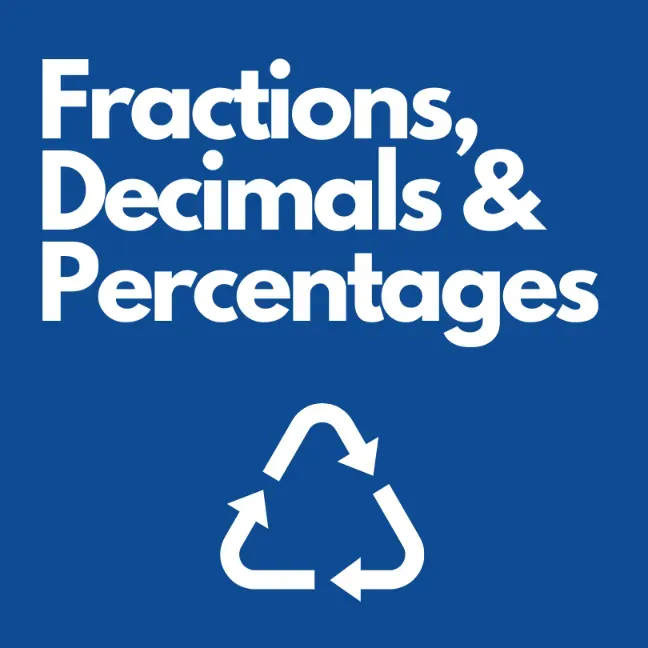Decimal to Percent Calculator
Convert decimal numbers to a percentage
Fractions, Decimals & Percentages: Decimals to Percent
See all maths calculators
Decimal to Percent Conversion Guide
The Decimal to Percent Converter is a useful tool that allows you to transform decimal numbers into their equivalent percentage representations. This comprehensive guide will walk you through the process of using such a converter, explain the concepts behind decimal-to-percent conversion, provide practical examples, and offer insights into common pitfalls and real-world applications.
Understanding Decimals and Percentages
Before diving into the conversion process, let's clarify some key concepts:
Decimals
A decimal is a way of writing fractions whose denominators are powers of ten. For example, 0.75 is equivalent to 75/100 or 3/4.
Percentages
A percentage is a way of expressing a number as a part of 100. It is denoted by the symbol %. For example, 75% means 75 out of 100, or three-quarters of a whole.
Converting Decimals to Percentages
The process of converting a decimal to a percentage involves two simple steps:
- Multiply the decimal by 100.
- Add the % symbol.
For example, to convert 0.75 to a percentage:
- 0.75 × 100 = 75
- 75%
Therefore, 0.75 = 75%
Examples of Decimal to Percent Conversions
Let's look at a table of examples:
| Decimal | Conversion Process | Percentage Result |
|---|---|---|
| 0.5 | 0.5 × 100 | 50% |
| 0.25 | 0.25 × 100 | 25% |
| 0.75 | 0.75 × 100 | 75% |
| 0.33 | 0.33 × 100 | 33% |
| 0.1 | 0.1 × 100 | 10% |
| 1.5 | 1.5 × 100 | 150% |
| 0.05 | 0.05 × 100 | 5% |
| 2.25 | 2.25 × 100 | 225% |
Common Mistakes to Avoid
When using a Decimal to Percent Converter, be aware of these common pitfalls:
-
Forgetting to multiply by 100: Remember, percentages are out of 100, so you need to multiply your decimal by 100.
-
Omitting the % symbol: Don't forget to include the % symbol in your final answer.
-
Misplacing the decimal point: Be careful when moving the decimal point; it should move two places to the right.
-
Confusion with fractions: Don't confuse decimals with fractions; 0.5 is 50%, not 5%.
-
Mishandling decimals greater than 1: Remember that decimals greater than 1 will result in percentages over 100%.
Practical Applications
Understanding how to convert decimals to percentages has numerous real-world applications:
Finance and Investing
Interest rates, investment returns, and financial ratios often involve decimal-to-percent conversions.
Example: If a stock price increases by a factor of 0.15, this represents a 15% increase.
Academic Grading
Many grading systems use decimals that are often converted to percentages.
Example: A grade point average (GPA) of 3.5 out of 4.0 can be expressed as 87.5%.
Statistics and Data Analysis
Data representation often requires converting decimals to percentages for clarity.
Example: If 0.68 of survey respondents prefer product A, this can be reported as 68% preference.
Science and Engineering
Many scientific calculations result in decimals that are more intuitively understood as percentages.
Example: If a material expands by a factor of 0.03 when heated, this can be expressed as a 3% expansion.
Real World Analogies (RWA)
To better understand decimal to percent conversions, consider these real-world analogies:
-
Sales and Discounts:
- A 0.20 discount on an item represents a 20% off sale.
- If you've saved 0.75 of your goal amount, you're 75% of the way to your target.
-
Progress Tracking:
- If you've completed 0.33 of a project, you're 33% done.
- If a battery is at 0.85 charge, it's at 85% capacity.
-
Sports Statistics:
- A batting average of 0.300 in baseball represents a 30% success rate at bat.
- If a team wins 0.60 of their games, they have a 60% win rate.
-
Nutrition:
- If 0.30 of a food's calories come from fat, this can be expressed as 30% of calories from fat.
- A food item containing 0.08 protein by weight is 8% protein.
These real-world analogies help to ground abstract decimal-to-percent conversions in concrete, everyday situations, making them easier to understand and remember.
Using Technology: Decimal to Percent Converters
While it's important to understand the manual process, Decimal to Percent Converters can quickly perform conversions, especially for complex decimals. When using such converters:
- Verify the input format required by the converter.
- Double-check your entries for accuracy.
- Understand the output format provided by the converter (number of decimal places in the percentage).
- Use the results judiciously, especially in professional or academic contexts where showing your work may be required.
The Importance of Understanding Decimal to Percent Conversions
Converting decimals to percentages is a fundamental skill that extends beyond simple arithmetic. It's crucial for many fields including finance, academics, statistics, and everyday calculations. By mastering these conversions, you enhance your numerical literacy and problem-solving skills.
Conclusion
Using a Decimal to Percent Converter to transform decimal numbers into their corresponding percentage representations is a valuable skill that enhances your ability to work with numerical data. Whether you're a student, a professional, or simply someone who enjoys working with numbers, understanding this process can improve your mathematical capabilities and practical problem-solving skills.
Remember, while converters are powerful tools, understanding the underlying concepts is crucial. Practice manual conversions alongside using the converter to develop a deep understanding of the relationship between decimals and percentages.
Key Takeaways
- Understand that a decimal represents a fraction with a denominator of a power of 10.
- To convert a decimal to a percentage, multiply by 100 and add the % symbol.
- Be aware of common mistakes such as forgetting to multiply by 100 or omitting the % symbol.
- Recognize the practical applications in finance, academics, statistics, and science.
- Use real-world analogies to better understand and remember decimal-to-percent conversions.
- While converters are helpful, understanding the manual process is crucial for developing mathematical intuition.
- Remember that decimals greater than 1 convert to percentages greater than 100%.
By mastering decimal to percent conversions, you'll have a powerful tool at your disposal for understanding and working with numerical data in various real-world scenarios.

